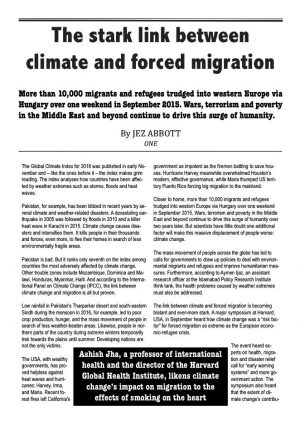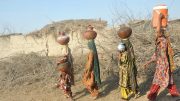 The Global Climate Index for 2018 was published in early November and – like the ones before it – the index makes grim reading. The index analyses how countries have been affected by weather extremes such as storms, floods and heat waves.
The Global Climate Index for 2018 was published in early November and – like the ones before it – the index makes grim reading. The index analyses how countries have been affected by weather extremes such as storms, floods and heat waves.
Pakistan, for example, has been blitzed in recent years by several climate and weather-related disasters. A devastating earthquake in 2005 was followed by floods in 2010 and a killer heat wave in Karachi in 2015. Climate change causes disasters and intensifies them. It kills people in their thousands and forces, even more, to flee their homes in search of less environmentally fragile areas.
Pakistan is bad. But it ranks only seventh on the index among countries the most adversely affected by climate change. Other trouble zones include Mozambique, Dominica and Malawi, Honduras, Myanmar, Haiti. And according to the International Panel on Climate Change (IPCC), the link between climate change and migration is all but proven.
Low rainfall in Pakistan’s Tharparkar desert and south-eastern Sindh during the monsoon in 2016, for example, led to poor crop production, hunger, and the mass movement of people in search of less weather-beaten areas. Likewise, people in northern parts of the country during extreme winters temporarily trek towards the plains until summer. Developing nations are not the only victims.
The USA, with wealthy governments, has proved helpless against heat waves and hurricanes: Harvey, Irma, and Maria. Recent forest fires left California’s government as impotent as the firemen battling to save houses. Hurricane Harvey meanwhile overwhelmed Houston’s modern, effective governance, while Maria thumped US territory Puerto Rico forcing big migration to the mainland.
Closer to home, more than 10,000 migrants and refugees trudged into western Europe via Hungary over one weekend in September 2015. Wars, terrorism and poverty in the Middle East and beyond continue to drive this surge of humanity over two years later. But scientists have little doubt one additional factor will make this massive displacement of people worse: climate change.
The mass movement of people across the globe has led to calls for governments to draw up policies to deal with environmental migrants and refugees and improve humanitarian measures. Furthermore, according to Aymen Ijaz, an assistant research officer at the Islamabad Policy Research Institute think tank, the health problems caused by weather extremes must also be addressed.
The link between climate and forced migration is becoming blatant and ever-more stark. A major symposium at Harvard, USA, in September heard how climate change was a “risk factor” for forced migration as extreme as the European economic-refugee crisis.
The event heard experts on health, migration and disaster relief call for “early warning systems” and more government action. The symposium also heard that the extent of climate change’s contribution to the 66 million people on the move globally remained hard to quantify exactly. Several experts however insisted it was important to factor in climate change in any analyses of why people emigrate, what happens to them during their journeys, and how it affects their health.
Ashish Jha, a professor of international health and the director of the Harvard Global Health Institute, likens climate change’s impact on migration to the effects of smoking on the heart – though smoking is known to cause heart disease, its contribution to death is hard to quantify against other factors such as diet, he says. It does not, however, prevent warnings against cigarettes.
Scientists forecast climate change will not just warm the planet. It will whip up weather extremes, intensifying storms and floods and leading to long heat waves and drought. All of these extremes are killing crops on a terrifying scale. Before the civil war, prolonged drought in northern Syria devastated agricultural livelihoods and was exacerbated by an inadequate government response.
The result? A million Syrians migrated internally to cities already stressed by the arrival of 1.5 million refugees from neighbouring Iraq. Economic, social and organisational pressures stemming from such large numbers of new arrivals can foster local unrest and even conflict, says Jennifer Leaning, director of the FXB Center for Health and Human Rights.
“The world is awash with wars and there’s quite a direct link to climate change. It’s not the only link, and it’s not a causal link. But there are associations between climate change, migration, entering alien spaces, conflict in those alien spaces, and then armed conflict. We’re very much concerned with how you prevent these wars, which is why we’re cycling back to climate change.”
But often the eye of this social storm is not barren wastelands or war zones, but cities. Particularly megacities, and South America is particularly vulnerable. These are becoming focal points for climate change impacts. Rapid urbanisation and crippling demand for housing, social and health services pile on pressure to already stretched physical and social infrastructure.
If the impact of climate change on migration is not fully known, the same is true of cities, according to the International Organization for Migration (IOM). Sea level rise, land degradation and desertification, as well as changes in water availability are some of the factors in the “interplay of migration drivers and environmental change”, reckons the IOM.
Additional migration to emerging metropolises in South America, Asia and Africa is likely to exacerbate vulnerabilities related to inequality and poverty. They are also likely to further hamper the ability of cities to adapt to climate change. Understanding the dynamics between migration, cities and climate change is an important priority of the IOM and others.
Michael VanRooyen, a professor of emergency medicine and of global health and population and a director at Brigham and Women’s Hospital in the USA, warns that though further study is needed to understand more on climate-related risks “uncertainty is not an excuse for inaction”. And “just because we can’t quantify it does not mean it’s not real.”
He adds: “Centuries of experience have shown where disasters are most likely to hit. We work pretty closely with the Philippines, for example, and we know, predictably, the Philippines is going to be hammered by 25 major storms a year. Two or three of these will be epic in nature. Just because we’re uncertain does not mean we should not act.”
Jez Abbott





